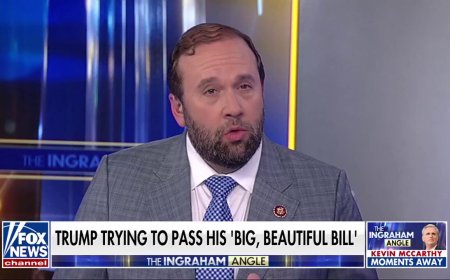The Meager Agenda of Abundance Liberals


Donald Trump’s victory last November and his shock and-awe first two months have left his opponents stunned, disoriented, and struggling to regain their bearings. For Democratic politicians, donors, pundits, and activists as well as center-right Never Trumpers, the most immediate task has been to slow down the assault on the country’s democratic institutions led by the oligarch Elon Musk. But the opposition is also engaged in a vigorous internal debate about what the Biden administration and the Democratic Party did wrong and what a new, more electorally successful agenda might look like. While many potential contenders are vying to define that agenda, one early favorite is a group of thinkers known as “abundance liberals” (or sometimes “supply-side progressives”).
If you are a regular reader or listener of the columnist and podcaster Ezra Klein of The New York Times, or the Substack blogger Matt Yglesias, or Jerusalem Demsas and Derek Thompson of The Atlantic, you are probably at least somewhat familiar with this perspective. Its central premise is that excessive red tape—from federal environmental statutes to local zoning rules to government agency procedures—is driving up the costs and slowing down the building of things the country desperately needs, from new housing to clean energy infrastructure.
While abundance liberals don’t all agree on everything, they are united by an overarching aim of a world of plenty: clean air, clean water, cheap renewable energy, affordable housing, high-speed rail, and an efficient, modernized electrical transmission grid. To bring us all that, they would unleash the full potential of nuclear and geothermal power, of liquified natural gas to complement renewables, of desalination, AI, and other technologies of the future that they believe can lift billions out of poverty and greatly improve living standards at home and abroad, all without devastating the planet.
They also converge around a critique of well-intended regulation. Klein and Thompson in their new book, Abundance, the author Marc Dunkelman in Why Nothing Works: Who Killed Progress—and How to Bring It Back, and The Atlantic’s Yoni Appelbaum in Stuck: How the Privileged and the Propertied Broke the Engine of American Opportunity, focus on rules and bureaucratic process as obstacles to progress, especially in major metropolitan hubs like New York City, Los Angeles, and San Francisco. They lament the way that industrial policy is bogged down by what Klein calls “everything bagel” liberalism—well-meaning but costly and time-consuming requirements, such as mandating DEI hiring policies, union labor, and child care centers in subsidies for green energy or new microchip factories. In support of their arguments, these writers frequently cite the work of likeminded researchers at center-left and center-right think tanks such as the Niskanen Center, the Breakthrough Institute, the Foundation for American Innovation, and the Mercatus Center—organizations with generally anti-regulatory outlooks and connections to Silicon Valley and energy interests.
Thompson describes the “Abundance Agenda” as a synthesis of ideological strengths: the left’s concern for human welfare, the libertarian instinct to cut through stifling regulations, and the right’s fixation on national greatness—but applied to the things that actually make a nation great: clean and safe cities, world-class public services, and widespread prosperity. As Klein writes, the abundance agenda would encourage the progressive movement to “[take] innovation as seriously as it takes affordability.”
These thinkers aren’t quite techno-libertarians à la Musk, but they inject a sense of optimism and vision in our politics. They reject the prevailing fatalism on both the left and the right—that progress is an illusion and decline is inevitable. Abundance as they describe it is also morally robust. Scarcity breeds reactionary politics. Authoritarianism and blood-and-soil nationalism feed on the belief that resources are finite and must be hoarded.
There’s a lot to like about these writers (many of whom have written for—or, in the case of Klein, started their careers at—the Washington Monthly). Their insurgency against the status quo represents what the Democratic Party is desperately trying to find. They articulate an optimistic vision of the future that goes beyond just resisting Trumpism, they’re skilled on social media, and they’re funny. Their message is tapping into potentially powerful political energy, especially among Millennial and Gen Z voters facing astronomical housing costs and existential climate anxiety. The abundance liberals deserve real credit for bringing early attention to the housing crisis, and their call to roll back residential zoning restrictions has been taken up by the grassroots YIMBY (“Yes in My Backyard”) movement and endorsed during the 2024 campaign by Kamala Harris and Barack Obama.
If you are a regular reader
of Klein or Yglesias, you
are probably familiar
with the central premise
of abundance liberalism:
excessive government red
tape is driving up costs and
slowing down the building
of things we desperately
need, from housing to clean
energy infrastructure.
At the moment, the abundance liberals seem like the closest thing we have to the Democratic Leadership Council in the 1980s: a group of centrist thinkers plotting a revival of liberalism by way of pragmatism and policy innovation. Like the New Democrats of that era, they show an admirable willingness to challenge their own side. They regularly call out progressives who have become reflexively opposed to growth, whether it’s liberal think tanks rejecting any permitting reform deal that compromises with natural gas, or affluent liberals in Berkeley coming up with environmental excuses to oppose new housing. The Johns Hopkins political scientist Steven Teles argues that the DLC analogy doesn’t sufficiently capture the depth and importance of the abundance movement, of which he is a leading light. He likens its thinkers to the Progressive Era intellectuals who made the case for the creation of the modern administrative state—but with the aim of reforming that state.
As skilled as they are, however, at making the case for rapid growth of supply in key sectors like transportation, housing, and energy, abundance liberals can be awfully sketchy about what policy solutions they favor. Of the few they do clearly advocate, some, like permitting reform, are wildly insufficient to the immense tasks at hand. Others, such as overturning residential neighborhood zoning rules, are less likely to produce new housing than to spark a political firestorm that could set back liberalism for years. Worst of all, while devoting so much attention to progressive contradictions, abundance liberals are almost completely silent on the alliance between corporate behemoths and antigovernment politicians that is the biggest threat to the world of plenty they envision, not to mention the republic.
If there’s one issue that animates abundance liberals above all, it is the crushing cost of housing. To be precise, they are animated by the crushing cost of housing in a handful of major affluent cities where they and most people they know live—New York, Washington, D.C., San Francisco, and so on. These writers understand that there are plenty of affordable homes in, say, Cleveland and St. Louis. But such places are not as “productive” as San Francisco or New York, Klein and Thompson write (see Zephyr Teachout’s review of Abundance). In their view, the failure to build enough housing in these coastal cities so middle- and working-class people from all over the country can afford to move there is the great tragedy of our times.
The core driver of this tragedy, abundance liberals argue, is restrictive zoning. Local laws that ban apartment buildings and mandate single-family homes have long constrained housing supply, especially affordable multifamily units. But over the past two decades, middle-class and affluent homeowners in desirable areas have weaponized these restrictions to block new construction, driving home prices ever higher. This in turn has led young, educated progressives in booming coastal cities who are priced out of the housing market to join the YIMBY movement, which abundance liberals champion. And that movement has one main demand: eliminate restrictive zoning laws and let property owners build what they want on their land.
State and local leaders in high-cost regions have begun taking up this libertarian cause. In 2019, Minneapolis became the first major U.S. city to end single-family exclusive zoning. The same year, Oregon became the first state in the nation to legalize duplexes, triplexes, and fourplexes—commonly known as “middle housing”—statewide. California in 2021 enacted a series of reforms, including laws that allow homeowners to split single-family lots and build multiple units, eliminate parking requirements near transit, and limit localities’ ability to block new housing development.
The movement to lift zoning restrictions is still new, but enough time has elapsed to begin to see how well it’s working, and the answer is … a little. Since Minneapolis pioneered the elimination of single-family zoning in 2019, 72 new duplexes and 37 triplexes (for a whopping total of 255 individual units) have been built. Los Angeles saw only 211 applications for multifamily construction in the year after the law getting rid of single-family zoning went into effect. A comprehensive study from the Urban Institute of land-use reforms across 1,136 cities from 2000 to 2019 found that they increased housing supply by only 0.8 percent within three to nine years of passage.
Why has broad zoning reform yielded such modest results, at least so far? The answer is that supply-side liberals didn’t fully consider the demand side of their policy. “The demand for two-flats and four-flats in car-dependent residential neighborhoods dominated by single-family homes just isn’t that high,” says Chris Leinberger, a development consultant and professor emeritus of real estate at George Washington University. The urban policy expert Alan Ehrenhalt agrees. “The problem here is that developers won’t be flocking to build cheap housing on these properties,” he wrote in Governing magazine.
Back in the 1970s, neoconservative scholars used the droll term “well intentioned” to describe liberal social policy experiments that didn’t work and created popular backlash that hurt the cause of liberalism generally. The term could apply to the crusade to eliminate zoning restrictions in residential neighborhoods. Not only has it failed so far to produce new housing at anywhere near the rate its advocates argue is necessary, but it tends to infuriate existing homeowners, especially affluent ones who have political connections and money for lawyers. If abundance liberals succeed, as they seem to be, in convincing senior Democratic leaders to push for broad zoning reforms, they could be unwittingly walking the party into a trap. In 2020, Trump accused Democrats of plotting to “destroy the suburbs” because of an Obama-Biden administration regulation meant to nudge municipalities toward residential zoning reform through tighter reporting requirements for HUD grants.
If Democrats are going to take on the politically fraught issue of housing affordability—and they must—they should do so with policies that are less likely to spark a voter backlash and more likely to solve the problem. Fortunately, there is such a policy: building dense residential communities on underutilized commercial land near transportation. Prime examples of this strategy are the mini downtowns in the D.C. suburb of Arlington, Virginia, that arose around Metro stations in the 1990s and similar ones going up along Rockville Pike in suburban Maryland. These “walkable communities,” Leinberger presciently observed in the Washington Monthly in 2010, work because they give people what they most want and can’t find in today’s market: housing with easy access to commuter rail or regular bus lines as well as restaurants, retail outlets, grocery stores, and other amenities. Real estate developers can make a lot of money building such projects, as long as municipalities let them.
Minneapolis has done just that. While its residential neighborhood zoning reforms haven’t produced much housing, a few years ago the city also lifted a cap on the height of residential buildings that can be constructed on commercially zoned land near some transit corridors from six stories to 30. Since then, it has seen an explosion of apartment building construction in these areas. The new condos and apartments are market rate, not subsidized “affordable” ones, yet so many have been built—more than 20,000 units in just a few years—that it’s had a measurable effect on housing affordability. According to research by the Pew Charitable Trusts, rent grew 13 percentage points less in Minneapolis than in Minnesota as a whole, and homelessness, which grew by 14 percent statewide, dropped by 12 percent in Minneapolis. Similar zoning reforms in other cities, such as New Rochelle, New York, targeted at increasing the supply of large apartment buildings around transit hubs have had similar success in holding down rent increases, according to Pew research.
At the moment, the
abundance liberals seem like
the closest thing we have to
the Democratic Leadership
Council in the 1980s: a group
of centrist thinkers plotting
a revival of liberalism
by way of pragmatism
and policy innovation.
Of course, not everyone wants to live in high-rise buildings, and there’s still a need to build more single-family homes. There, a major problem is consolidation in the home construction industry. Since the 2007 financial crisis, the number of homebuilders has plummeted by 65 percent, according to a Johns Hopkins University study. Two companies, D.R. Horton and Lennar, account for nearly as much new construction as the next eight largest builders combined. The Hopkins study authors estimate that when a local market loses competition in the homebuilding market, housing production drops by 15 percent in value, 16 percent in total square footage, and 11 percent in number of units. Prices go up, too.
Abundance liberals have little to say about homebuilder consolidation—or about the broader problem of growing corporate monopolization, as we’ll see.
Abundance liberals argue—rightly—that the United States must dramatically expand its energy generation and transmission capacity to combat climate change and to power emerging technologies that demand immense electricity. At the heart of this challenge lies the complex task of building the high-voltage power lines that transport electricity from where it’s generated, often in sparsely populated regions of the country, to where it’s needed, predominantly in metro areas often hundreds of miles away. Without robust transmission infrastructure, renewable energy remains stranded, unable to reach the communities and industries that need it most. This problem has become particularly acute as renewable energy development accelerates, with many solar and wind projects facing yearslong delays in connecting to the grid due to insufficient transmission capacity.
While devoting so much
attention to progressive
contradictions, abundance
liberals are almost completely
silent on the alliance between
corporate behemoths and
antigovernment politicians
that is the biggest threat
to the world of plenty
they envision, not to
mention the republic.
The main bottlenecks in this mounting crisis, abundance liberals argue, are federal environmental statutes, and one above all: NEPA, short for the National Environmental Policy Act. Signed into law in 1970, NEPA requires federal agencies to assess environmental impacts before approving major building projects. As Marc Dunkelman explains in Why Nothing Works, courts over the years interpreted NEPA as allowing individuals and groups outside of government to use the law to file suits to slow down or block large-scale building projects, something the lawmakers who crafted the statute never intended (see Alan Ehrenhalt’s review of Why Nothing Works). As a result, NEPA has become increasingly burdensome, particularly for large-scale transmission projects that must generate voluminous environmental-impact statements, which take an average of 4.3 years to complete, according to analysis from the Niskanen Center.
Environmental groups have been especially vigorous in using NEPA lawsuits to halt building projects, and the law’s strongest defenders are on the left. That a foundational progressive law is being used to slow deployment of the renewable energy needed to save the planet from climate change is a central plank in the abundance liberal argument that progressivism has become the chief enemy of progress.
Abundance liberals are right that NEPA needs to be reformed. What they don’t say is that progressives aren’t primarily responsible for blocking that reform. In 2022, the Senate took up a permitting reform bill authored by centrist Democrat Joe Manchin that would have greatly restricted the ability to bring NEPA lawsuits. The measure would also have strengthened the authority of the Federal Energy Regulatory Commission (FERC) to preempt state and local opposition to the building of electric transmission lines that cross jurisdictions—another key item on the abundance liberal wish list. A strong majority of Democrats voted for the legislation. An equally strong majority of Republicans opposed it. After the bill died, Manchin, normally the scourge of the progressives, left no doubt which side killed it: “Once again, Mitch McConnell and Republican leadership have put their own political agenda above the needs of the American people.” Now that Trump is back in office, he is streamlining fossil fuel permits while punishing solar and wind—all without receiving any pushback from his own party.
But here’s the crucial point: Even if we eventually succeed in streamlining permitting through NEPA reform and expanded FERC authority, we still won’t be able to deploy renewable energy on the scale abundance liberals believe—rightly—is needed. That’s because of an even bigger bottleneck: corporate power.
America’s electric grid is under the control of regional transmission organizations (RTOs) that are in turn dominated by incumbent electric utilities. These utilities are regulated corporate monopolies that earn guaranteed returns on capital investments and fuel costs. They make money building and operating fossil fuel plants that require continuous fuel purchases. Renewable energy, with its high up-front costs but minimal operating expenses, offers fewer opportunities for ongoing profit under this model. Combined with the quarterly profit pressures of investor-owned utilities, this creates a systematic bias against the long-term infrastructure investments needed for renewable integration.
These utilities and RTOs employ a range of tactics to protect their monopoly positions and fossil fuel investments, as detailed by the Roosevelt Institute and by Sandeep Vaheesan in his book Democracy in Power: A History of Electrification in the United States (see Shelley Welton’s review of Democracy in Power). One is slow-walking grid connections for new solar and wind projects, creating byzantine interconnection processes that can take years to navigate. Another is requiring expensive technical studies and grid upgrades to be paid for by renewable developers, while similar costs for fossil fuel plants are typically spread across all ratepayers. In many regions, the interconnection queue—the line of projects waiting to connect to the grid—has become so backlogged that some developers must wait a decade just to plug into the system. PJM, one of the country’s largest RTOs, has said most projects entering their interconnection queue are unlikely to come online before 2030. Utilities also frequently underestimate future renewable energy growth in their transmission planning, leading to chronic underinvestment in grid capacity. When they do build transmission, they often design it around their own generation projects rather than enabling open access for independent developers. This strategic planning creates a self-fulfilling prophecy: by not building adequate transmission, they ensure that renewable energy remains constrained by infrastructure limitations.
When all else fails, utilities use their political clout to lobby the regulatory boards that oversee them and the state legislatures that oversee the regulatory boards. That’s what Mississippi’s utility, Entergy, has done—so far successfully—to block a 320-mile transmission line that Pattern Energy, a private renewables developer, has been trying for a decade to build to link Texas’s renewables-rich grid to the Southeast.
This effective veto power utilities and their RTOs have over the electric grid is an immense obstacle to the transmission and distribution of renewable energy. It’s also one abundance liberals almost never talk about.
For abundance liberals, the inability of the U.S. to build infrastructure quickly and cost-effectively is a defining failure of government. And there is no better illustration of that failure, they say, than California’s ill-fated high-speed rail project. When the state’s voters first approved a $10 billion bond issue for the endeavor in 2008, it was projected to be completed by 2020 at a cost of $33 billion. Its price tag has since ballooned to $128 billion, and the initial segment—which won’t even connect Los Angeles and San Francisco—isn’t expected to be completed until sometime between 2030 and 2033. As Klein and Thompson point out, “In the time California has spent failing to complete its 500-mile high-speed rail system, China has built more than 23,000 miles of high-speed rail.” Abundance liberals blame America’s local “vetocracy,” where lawsuits, environmental reviews, and endless bureaucratic hurdles stall major projects, making it nearly impossible to build at scale.
Yet California’s high-speed rail is a uniquely Californian debacle—no other state has attempted such an ambitious project—and its failure was also foreseeable. More than a decade ago, Phillip Longman, a Washington Monthly senior editor, warned that a national high-speed rail system of the kind progressives like Klein and Thompson pine for isn’t just difficult to build for the reasons they bemoan—right-of-way disputes, litigation, environmental regulations—but also because, unlike in Europe and Asia, government in the United States has no expertise in constructing and owning long-distance rail lines, a task it has historically left to the private sector. Moreover, the United States has no great need to spend hundreds of billions of taxpayer dollars on a high-speed rail system that would mostly serve affluent travelers shuttling between metro areas. For a fraction of the cost and time, the federal government could develop a robust medium-speed passenger rail network using existing privately owned tracks that would also provide connectivity to the cities and towns in between big metro areas—if only Washington required monopoly freight rail companies to make those tracks available.
Abundance liberals are on firmer ground when critiquing the soaring costs and slow delivery of more conventional projects for which state and local governments have traditionally been responsible, such as mass transit. Because so many abundance liberals live in the D.C. area, one of their go-to examples of botched transit projects is the Purple Line, a vital but much delayed 16.2-mile light rail meant to connect working-class and affluent Maryland suburbs and those communities to D.C.’s Metro system. In an interview with Klein, Jerusalem Demsas blamed the delays on “wealthy homeowners in Chevy Chase, Maryland,” bringing nuisance environmental lawsuits. In a Vox piece, Matthew Yglesias similarly focused on local opposition.
Back in the 1970s,
neoconservative scholars
used the droll term “well
intentioned” to describe
liberal social policy
experiments that didn’t
work and created popular
backlash that hurt the cause
of liberalism generally. The
term could apply to the
abundance liberal crusade to
eliminate zoning restrictions
in residential neighborhoods.
In 2022, the Washington Monthly published an in-depth investigation of the Purple Line. That investigation, by Eric Cortellessa, determined that a NEPA-based lawsuit brought by those wealthy landowners was responsible for a year and a half of the delay since the project’s funding was secured in 2015. What caused the remaining slippage? Governor Larry Hogan’s administration added almost two years by changing the project’s already completed specifications. A right-of-way dispute with the monopoly freight rail company CSX caused a five-month delay costing $187.7 million. New state environmental regulations required design changes that added 976 days and another $519 million. But the biggest blow came from the Hogan administration’s botched management of the contractors, which added $1.4 billion and five more years to the project. It is currently scheduled to open in 2027.
The Purple Line is a fair representation of transportation projects generally. Permitting delays based on federal laws like NEPA sometimes drive up costs. But they are typically only one of many factors.
Indeed, permitting delays play virtually no role at all in some of government’s most common, and commonly mismanaged, construction projects. Consider road resurfacing, a task that seldom requires complex permitting because no new land is being taken. A 2023 Yale Law and Economics study of highway resurfacing projects in all 50 states found that two variables overwhelmingly explain cost overruns. The first is bureaucratic “capacity”—that is, the number, skill level, and experience of employees at state departments of transportation—which has generally declined in recent years. This drop has led state DOTs to rely on outside consultants to plan and oversee the resurfacing projects. The second variable is a fall in the number of contractors available to bid on the projects. This is due largely to industry consolidation, which has shrunk the number of construction firms in 70 percent of U.S. states. The Yale researchers found that outsourcing infrastructure planning increased costs by 20 percent per mile, while each additional bidder on a project corresponded to an 8.3 percent reduction in cost.
The effective veto power that
monopoly corporate utilities
have over the electric grid
is an immense obstacle
to the transmission and
distribution of renewable
energy. It’s also one
that abundance liberals
almost never talk about.
This combination of capacity-starved bureaucracies and lack of contractor competition goes a long way toward explaining skyrocketing costs in another vast area of public life: national defense. The F-35 joint strike fighter is more than a decade behind schedule and $183 billion over original cost estimates, according to the GAO—a figure greater than the entire projected cost of California’s high-speed rail project. The Zumwalt-class destroyer, billed as the future of naval warfare, ran into so many design flaws that the Navy canceled it last fall after delivering only three of a planned 32 ships at a cost of $24.5 billion. These and other examples of weapons procurement catastrophes have occurred with such mind-numbing regularity over so many years that the public hardly notices anymore.
Their root causes also go back decades. As the former congressional military budget staffer Mike Lofgren reported in these pages last summer, beginning with Ronald Reagan and accelerating with the administration of Bill Clinton, the defense industry massively consolidated: 51 major aerospace and defense contractors became five during the 1990s. Meanwhile, private industry successfully lobbied to take over more engineering and design work that had traditionally been done in house by the military services and the Defense Department. The Navy, for instance, reduced its naval architecture and engineering staff by 75 percent, from roughly 1,200 to 300. With fewer experienced civil servants managing the contracts, and fewer contractors available to bid on them, each with more market power, costs have naturally soared.
Other factors contribute to the problem, including the military’s penchant for stuffing weapons systems with fragile, unproven, and unnecessary high-tech tools (“everything bagel” policymaking was invented in the Pentagon, not the Biden administration). What doesn’t explain the exploding prices and slow delivery of weapons systems? Permitting. Perhaps not coincidentally, abundance liberals have had little to say about the subject.
If all you have is a hammer,” the psychologist Abraham Maslow famously observed, “everything looks like a nail.” For abundance liberals, the nails are government-created bottlenecks. Remove them (via the claw end of the hammer, to extend the metaphor) and a world of plenty will flow.
In health care, they argue, the key bottleneck is doctors. The United States produces too few of them because of a cap on the number of medical residencies and the federal funds to pay for them—artificial constraints orchestrated by the powerful medical profession to protect doctors’ high incomes. Increase the supply of doctors, the theory goes, and the price of health care will fall. “Fixing this problem is eminently within the powers of the federal government,” Klein and Thompson write in their book.
It is true that the medical profession behaves like a cartel. It’s also true that increasing the number of certain kinds of doctors—especially primary care physicians, with their focus on prevention and disease management—might bring down health care costs under normal market conditions.
The problem is that health care is not a normal market. Among its many oddities is that few people can do meaningful comparison shopping to judge the value of different doctors, hospitals, or procedures. That’s why in health care increased supply and competition often leads not to lower prices and greater efficiency, but to increases in unnecessary surgery and testing. A well-established finding, for example, is that the number of heart operations performed in a community correlates with how many cardiologists are in local practice, not with how many people need a stent or a bypass. It is the same with MRI machines and many other expensive medical technologies: the more they are available, the more they are used, which drives up health care spending, often with little if any measurable clinical benefit.
An even bigger problem abundance liberals haven’t grappled with is industry consolidation. Hospitals have merged into giant systems that now control more than half the beds in the vast majority of metro areas. They have also purchased freestanding physician practices, diagnostic labs, and other parts of the health care delivery system. This has given the hospitals so much market clout that they can dictate prices to the insurance companies—and in many markets the hospital groups have acquired the insurance companies, too, and vice versa. Similarly, the overwhelming cause of high drug prices is not insufficient numbers of pill factories, but monopolies up and down the supply chain charging monopoly pricing. Those price hikes lead to higher insurance coverage costs for employers, which are then passed on to employees in the form of lower wages and higher copays and deductibles. With the commercial health care market this locked up, even a sizable increase in the supply of doctors will have little effect on costs.
Government-run insurance programs like Medicare have done a better job of controlling costs. These programs, however, suffer from fraud and unintentional overpayments costing taxpayers more than $100 billion a year. Here, the problem is, once again, bureaucratic capacity. Medicare, Medicaid, and the Children’s Health Insurance Program (CHIP) account for roughly 23 percent of all federal spending, but the agency that oversees that spending, the Centers for Medicare and Medicaid Services (CMS), employs just 0.3 percent of all federal employees. As the public administration scholar Don Kettl recently noted in the Monthly, “CMS isn’t a large bureaucracy—it’s a small bureaucracy charged with overseeing a mammoth contractor system.”
The heart of the government capacity problem is that for half a century, politicians in both parties, bowing to or playing up the anti-bureaucrat attitudes of voters, have kept government agencies on a starvation diet even as they’ve asked them to deliver more and more services. Consider this: The federal government today has roughly the same number of civilian employees as it had during the Lyndon B. Johnson administration, even though federal spending has quintupled in inflation-adjusted dollars.
Washington has coped with this soaring workload by relying more and more on contractors (many of them behemoths like Deloitte and Booz Allen Hamilton) for administrative tasks once done by civil servants, including managing the work of other contractors. It has also routed its spending through state governments whose bureaucracies are similarly stripped of talent. As with road resurfacing and weapons procurement, this dynamic has led to poor government performance and higher cost to taxpayers.
Supply-side liberals don’t deny the importance of government capacity in achieving greater abundance. Klein and Thompson describe the problem in vivid detail, and the Niskanen Center has produced impressive studies on the subject. Much of that work, however, is deregulatory in nature, focusing on the need to eliminate unnecessary procedures that get in the way of civil servants doing their jobs. For instance, Jennifer Pahlka, a Niskanen senior fellow and Barack Obama’s former deputy chief technology officer, has pointed out that government agencies can’t even update their websites without first going through time-consuming rounds of public comments thanks to the requirements of a statute, the 1980 Paperwork Reduction Act, that was passed before the internet existed.
The Trump-Musk attack on
the federal bureaucracy could
lead to epic government
performance failures—a
gutted CDC unable to
respond to a bird flu epidemic,
or Social Security payments
that don’t get delivered. That
could shift public opinion
in favor of shoring up the
federal government and
taking on unaccountable
corporate power.
Cutting such procedural red tape, as Pahlka and others suggest, is a crucial part of any strategy to rebuild government capacity. But that alone won’t come close to matching the scale of the problem. To align its mission with its internal resources, the political scientist John Dilulio, a former adviser to George W. Bush, has argued that the federal government needs to hire an additional million civilian employees.
Abundance liberals haven’t endorsed actions quite that dramatic, but they at least acknowledge that their agenda depends on a buildup of government capacity. The same can’t be said for the fight against corporate monopoly, a subject about which they are surprisingly silent.
That may be because they see monopolies as drivers of innovation. In their book, Klein and Thompson write with awe about how Bell Labs, in its mid-20th-century heyday as the development arm of the telephone giant AT&T, came up with the electronic transistor and other technologies that would define the future.
As a state-sanctioned monopoly, AT&T could invest in every facet of telecommunications science without concern for short-term profits, which gave its scientists and engineers the freedom to pursue ambitious projects over decades. This long-term security was essential for many of Bell Labs’s most important technological advances, such as fiber optics and electronic switching, which took decades to develop.
What the authors don’t say is that AT&T wasn’t interested in exploring the potential of the transistor its own scientists invented out of fear that it would compete with its existing vacuum tube business. As Barry Lynn of the Open Markets Institute has written, only after the Federal Trade Commission brought an antitrust suit against AT&T for hoarding valuable technology did the company agree to license its patent for the transistor and other technologies to outside companies like Motorola and a start-up called Texas Instruments. It was the government’s suit against AT&T, said Intel founder Gordon Moore, that “started the growth of Silicon Valley.”
Getting rid of the stupid
rules that slow progress
and add unnecessary costs
is an excellent idea. But it’s
not remotely capable, by
itself, of unleashing the
prosperity and plenty that
abundance liberals promise.
Today’s tech giants engage in similar patterns of innovation hoarding, but through different mechanisms. Companies like Meta and Google routinely acquire potential competitors and promising technologies, often letting them wither—essentially a version of the National Enquirer’s “catch-and-kill” tactic. This concentration of technological capacity creates new bottlenecks in precisely the sectors—from artificial intelligence to clean energy—that abundance liberals hope will drive future prosperity.
By now, it may have occurred to the alert reader that with a leading member of the tech oligarchy having seized control of the federal bureaucracy and actively decimating its capacity in constitution-defying ways, now might be a good time for abundance liberals to expand their thinking about what the real roadblocks are to a more plentiful America.
The Trump-Musk attack on the federal bureaucracy might be the start of a new authoritarian era. The more likely outcome, however, is epic government performance failures—a gutted CDC unable to respond to a bird flu epidemic, for instance, or Social Security payments that don’t get delivered, or even worse. Such disasters could shift public opinion in favor of shoring up the federal government and taking on unaccountable corporate power.
If that happens, the anti-MAGA opposition will need a bigger agenda than the one abundance liberals currently offer. Decluttering bureaucratic procedures won’t be enough to strengthen government capacity. We’ll need to hire far more bureaucrats, offer higher pay to recruit those with the needed skills and experience, and beef up antitrust enforcement agencies like the FTC. Permitting reform won’t be enough to give us a modern electric grid. We’ll need a new government agency that can construct and manage new renewable power generation and transmission lines when utilities refuse, as the Tennessee Valley Authority did in the 1930s. Training more doctors won’t be enough to meaningfully bring down health care costs. We’ll need the federal government to break up provider monopolies and impose a “Medicare prices for all” regime on commercial health care, as Phillip Longman has advocated.
Klein opened one of his podcasts earlier this year with a smart observation. Presidencies in their second terms, he noted, are usually “intellectually exhausted,” and Trump’s might have been, too, had he won in 2020. Instead, he and his movement had four years out of power, during which “the ferment driving MAGA’s ideas deepened quite a bit.” In 2024, Trump ran on those ideas and won. Now he’s acting on them, good and hard.
For better or worse, Democrats have been given a similar time-out. They need to treat it as an opportunity to do what MAGA did: develop and coalesce around a set of ideas (but not crackpot ones) that can command a majority of voters.
For that, they will need a lot more than what’s currently in the abundance liberal playbook. In an era when tech oligarchs openly work to hollow out the administrative state and monopolists actively suppress innovation, we need our smartest and most influential liberal thinkers to confront power rather than just process. After all, Progressive Era intellectuals didn’t just advocate modernizing government bureaucracies but also taking on corporate monopolies. And the Democrats who found success in 2024 weren’t technocrats promising AI-driven innovation and efficiency, but populists like Pat Ryan in New York who raged against corporate profiteering.
Getting rid of the stupid rules that slow progress and add unnecessary costs is an excellent idea. But it’s not remotely capable, by itself, of unleashing the prosperity and plenty that abundance liberals promise. And overpromising and underdelivering is a mistake Democrats cannot afford to make again. The road to abundance will be paved by a government that knows how to pave roads—and one strong enough to stand up to the corporate interests who prefer that those roads remain unbuilt.











































